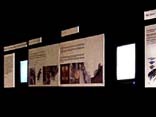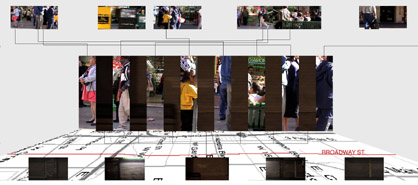|
|
||||||
| image | activities | contacts | links | italiano | ||||||
|
|
||||||
|
introduction |
The UCLA Department of Design | Media Arts is led by faculty who are
educating future professional designers and media artists by teaching
them the fundamentals of Design, Media, and the Arts, and encouraging
experimentation and innovation. Providing an extensive education in
Design and Media Arts practice, history and criticism, the Department
fosters a critical and creative exploration of emerging forms of communication,
typographies, interaction and interface design, ubiquitous computing,
virtual environments, information spaces, networked agents and all other
pertinent areas of research. This uniquely challenging program invites
students to balance aesthetic sensibility with logical reasoning, formal
theories with practical application, and contemporary thought with historical
perspective. The dynamic nature of the program reflects the constant
state of flux and change characteristic of living in our increasingly
technological world. Recognizing that the digital arts movement is international
in scope, we have developed a visiting artist program and encourage
our students to engage their peers in different parts of the world.
At the successful completion of the program students are expected to
have developed both an aesthetic sense for design and a mastery of the
technology necessary to innovate. Our faculty is committed to helping
students become creative, smart thinkers who are active participants
in shaping the world we live in. Victoria Vesna, Chair |

Installation at the Stazione Leopolda, Florence (photo by: Omar Cotza) |
||||
| Sur(face):
Relocating the Moving Image Instructor: Christian Moeller, D. Scott Hessels (T.A. Osman Khan) |
||||||

Sur(face): Relocating the Moving Image. News in the Coffee by Jin Lee With recent technological advances in cameras, screens, and projectors, the moving image is suddenly appearing in places never before possible. This new course considers a direction in the field of design that is using digital video technology, and hopes to foster the invention of new products that become more expressive, more functional through the incorporation of the moving image. Students created three digital video works for the class, an exercise in creating impact with only moments of exposure, a new form of branding, and a new invention that uses the moving image in a way that increases the expressiveness or functionality of the design. The course was able to consider the design functions that both architecture and moving images share. For example, each can be used to define public and private space, each can act as windows and mirrors and each can connect and mediate following the temporal rules of time based media. (Advanced undergraduate class, duration: 10 weeks, Special Topics in Area Studies) |
Christian
Moeller is an artist and Professor in the Department of Design |
Media Arts at UCLA. He studied architecture at the College of Applied
Sciences in Frankfurt and at the Academy of Fine Arts in Vienna. In
1990 he founded his own studio and media laboratory in Frankfurt. From
1995 to 1997 he headed the ARCHIMEDIA Research Institute at the College
of Design in Linz, Austria. He was a professor at the State College
of Design in Karlsruhe, Germany until he moved to the United States
in the year 2001. D. Scott Hessels is a media artist and independent filmmaker who produces both commercial and experimental work in several different media including film, video, web, and performance. Before teaching digital video at UCLA, he taught at Otis College of Art and Design and lectured at USC and abroad. In the broadcast industry, he was head of technology and operations for two Los Angeles television stations and two national cable networks. |
|||||
| Transient:
Reactive/ Interactive Installations Instructor: Christian Moeller |
||||||

Transient: Reactive/ Interactive Installations. TIME GAPS by Daniel Sauter The weirdly beautiful ambience of Los Angeles, pulsing with neon light and electronic billboards, is not a conscious, deliberately created event. The electronic city is a flood of potentially decodable signs, tolerable only by someone who has given up on reading it. Whereas advertising attempts the impossible goal of "communication," here the goal is the creation of event. In this way, the event is the time and place for which sensation itself becomes the content of the composition. The class introduces the creative use of electronic sensor technology and video motion tracking to build reactive or interactive environments on the topic of transient phenomena in the urban and cultural context of Los Angeles. All works were presented at the exhibition LA LA LA, Westweek 2003, at the Pacific Design Center in West Hollywood. (First year graduate class, duration: 10 weeks, Interactive Environments) |
||||||
| MFA
Thesis Project |
||||||

Transient: Reactive/ Interactive Installations. sur la table by Osman Khan Final year MFA candidates are expected to complete an individual thesis project that incorporates in-depth research and theoretical exploration of a topic, culminating in a final exhibition of work. Two thesis projects from the 2003 graduating class exploring the intersections of Media and Architecture are presented. (Second year graduate class) |
||||||
| site
hosted by ARCH'IT rivista digitale di architettura www.architettura.it |
||||||
